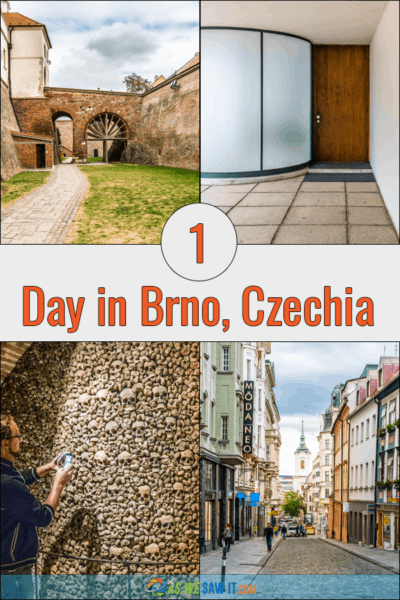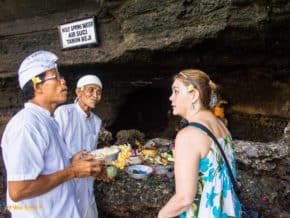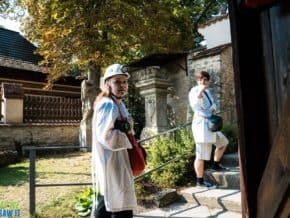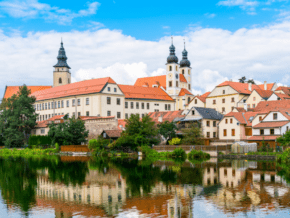You have to love a town with a name like Brno. Who but the Czechs could create a language with words that have no vowels? I mean, we stayed at a hotel on Zelny trh!
They might spend a weekend in Prague, but it seems that most people don't explore much more of the Czech Republic . Okay, maybe they'll do a few day trips like Kutna Hora or Bohemian Switzerland, but few foreign tourists think about visiting Brno.
I'm going to tell you why you should visit Brno in this article
Why bother visiting Brno?
We almost didn’t visit Brno ourselves, but Czech Tourism talked us into it. They were right: it makes an ideal base for day trips around the southern Moravia region. I’m glad we took their advice.
Four nights in one place enabled us to see all these places without having to change hotels:
- Brno,
- Moravian Karst,
- Lednice-Valtice complex,
- Mikulov,
- Trebic, and
- Telc
But let me tell you, navigating Brno’s narrow one-way streets is not for the faint of heart—especially at twilight! Had it not been for Waze, I don’t know what we might have done, because Brno is the Czech Republic’s second-largest city after Prague. Even worse, our hotel was in the middle of City Center, which is full of one-way streets.
I was sure we were going the wrong way a few times, but no police stopped us, so we kept driving. We both heaved a huge sigh of relief when we finally parked the car.

How to get from Prague to Brno
Regardless of how you choose to travel, it takes approximately 2.5 hours to get to Brno from Prague. Prices vary, and Czech Transport does not offer a discount for round-trip tickets. Here's a link to their website.
- Take the bus. Czech Transport offers numerous buses daily between Prague and Brno. Buses have leather seats, toilets, electric sockets, Wi-Fi, and complimentary hot drinks.
- Take the train. This option is perfect if you (or a child) like to move around. Czech Transport offers 12 direct trains daily. The fastest train takes 2 hours and 40 minutes. Booking is possible 90 days in advance.
- Hire a driver. You can book a private transfer with Viator and let a personal chauffeur drive you from Prague to Brno. Nap or relax in complete privacy or enjoy views of the surrounding countryside along the way.
- Rent a car. Car rental is more affordable than hiring a driver and provides the highest level of flexibility. We rented a car for our 3-week road trip around the Czech Republic, and it made all the difference.
ⓘ BUDGET TIP: When comparing prices, remember that some prices are quoted per person, while others are per group.
Where to stay in Brno

Zelný trh is one of Brno’s most beloved public squares. People have been selling produce there since the middle ages, and it has a practical name. Its name, zelny trh, actually means “cabbage market” in Czech.
It’s also a lot of fun to try to say. My tongue had a lot of fun flipping around the word trh while we were there.
The best thing about staying on Zelny trh is that a lot of the city’s best attractions are within walking distance. The most unusual attraction is Brno’s Underground Labyrinth. Plus, a shopping mall is only a couple of blocks away, and you’re spoiled with the choice of nearby restaurants.
We stayed at the Grandezza Hotel Luxury Palace, and we loved how our windows opened onto the square. But since it was already dark, we went in search of a place to enjoy dinner with a pivo. The Czechs hold the record for beer consumption per capita. Proof that it’s almost always a good time for a Czech beer.
The square’s centerpiece is Parnas Fountain, which was built in the 1690’s. The Baroque fountain symbolizes a cave made of natural boulders, but it was hard to make out, because it was being restored while we were there. The rocky parts were obvious. What wasn’t obvious was that its statues allegorically represent three ancient empires – Babylonia, Persia and Greece. I have a good imagination, but it doesn’t work very well with scaffolding in the way.
A one day Brno itinerary
Brno may not seem visit-worthy at first glance, but it is. The city is full of intriguing attractions and things to do, not to mention a UNESCO World Heritage Site. I think we found the best things to see in the one day we dedicated to sightseeing in Brno. We could have fit in a couple more had they stayed open later.
10:00 – Spilberk Castle
Our day in Brno began with a short walk to Špilberk Castle (hrad Špilberk). We'd have started earlier, but they weren't open.
Well … not so short, actually. Even though the castle is only a few blocks away according to the map, Spilberk sits on a steep hill, so you must navigate up a lot of winding paths to get to its gate. We passed young couples, senior citizens walking their dogs, and athletes walking the hill to stay in shape. They're gluttons for punishment, if you ask me. All of ‘em.
Touring through the 13th-century fortress was fascinating. Our guide brought us through its dark casemates, castle interior, and up its tower, all the while explaining the castle’s history. Špilberk Castle has been everything from a royal castle and seat of the Moravian royalty to a monumental Baroque fortress, the toughest prison of the Austrian monarchy, and a military barracks.
Even though it was founded by beloved Czech king Přemysl Otakar II, the castle made its darkest mark on history during its time as a prison. Not only “regular” murderers, thieves, or arsonists did their time here, but also so-called state prisoners. The upper classes had to be cautious not to offend the Habsburg rulers. Walk through its casemates, and you'll see why no one wanted to be imprisoned there.
Nazi Germany occupied the country during World War II, and they took over the castle. They turned the casemates into offices. You can still see their original telegraph lines strung along the brick walls.

While everything was interesting, my favorite memory of our visit is the remarkable view from the tower. It might have been something to see the museum too, but with only one day in Brno, we had to give it a miss.
- Address: Špilberk 1, 662 24 Brno
- Phone: +420 542 123 611
- [email protected]
12:00 – Lunch at Spilberk Castle
Although we had planned our entire itinerary around UNESCO World Heritage Sites, we had despaired of seeing the one in Brno. Tours had sold out months before. Then, we got a call that our partners at Czech Tourism had wrangled two tickets for us. I can’t begin to express how excited and grateful I was. We were going to see Villa Tugendhat after all!
With two hours to spare, we opted to eat in the castle’s historic dining room. We would rather not waste time looking for a lunch place somewhere in town.
Big mistake. Despite the restaurant's clear visibility through its windows, we couldn't see the entrance. No. Sign. Anywhere. Eventually we opened an unmarked door in a passageway, and there it was. No wonder that we were the only ones in the place!
It seemed to take ages to get our food. It was nearing half past one when we finally got the bill, and we still had to get to the villa—on the other side of Brno! Adding to the stress, there was a biking event in town, which meant all the roads around the castle were closed. Ultimately, we decided to go in search of a hotel and ask the concierge to call for a taxi.
The taxi arrived with 20 minutes to spare. Finally, we were on our way. Whew!

2:00 – Villa Tugendhat
I can see why tickets are so difficult to get. Villa Tugendhat has had such an influence on modern housing design that it is featured in every college textbook of architecture. It’s even been called one of the four most important villas of the world.
Now, we may not know much about building design, but even we were impressed by this house. I could live here. The house is named for Fritz and Greta Tugendhat, the Jewish German couple who built it, not for its renowned German architect (Mies van der Rohe). This is modern living at its best, with disappearing windows, clean lines, exotic wood and stone, and plenty of light and open space. And the view is incredible!
The house’s story is sad. The Tugendhats didn’t live there for long. They had to flee to Switzerland when the Nazis took over. Their home ended up in the hands of the Gestapo, and then later, the Soviet military used it. And they destroyed the place with all their remodeling.
Greta Tugendhat was able to explain the original design in the late 1960s, but it wasn’t until recently that UNESCO added it to its World Heritage list and it was completely restored. Now that we’ve been, we’d say that it’s worth visiting Brno just to see this house.

How to see the Tugendhat Villa in Brno
Villa Tugendhat is open from Wednesday to Sunday from 9:00 to 17:00. Online ticket sales HERE.
Entry fees: 300 Kč – Photographs in the interiors of the Villa are permitted without the use of a flash and a tripod. A “photo-ticket” can be purchased directly at the cash desk for CZK 300.
- Address: Černopolní 45, 613 00 Brno
- Phone: +420 515 511 015
- [email protected]
- http://www.tugendhat.eu/en/
ⓘ TIP: Villa Tugendhat is extremely popular. Book your tour at least 3-4 months in advance.
4:00 – St James Ossuary
Leaving the beautiful house, we walked back to a main street, where we caught a tram to see the ossuary under St. James Church.
What makes St. James Ossuary unusual is that it wasn't discovered until 2001, and that was completely by accident. The bones were discovered while the city was surveying for the Brno Underground. St. James Square was once the churchyard for St. James church. Eventually, the churchyard was closed down and this ossuary was forgotten.
Containing the bones of over 50,000 people, St. James Ossuary is the second-largest in Europe; only the Paris Catacombs is larger.

Like many other churchyards, wars, cholera and plagues quickly overwhelmed the space. They began to open graves a decade or so after burial and remove the remains to make room for “new residents.” The bones were stacked in underground areas specially designed for the purpose. Eventually, water and mud began to invade. It took over 10 years to get the bones cleaned and re-stacked. The ossuary opened to the public in 2012.
It was worth visiting I guess, though we saw it all within 15 minutes. Dan and I went upstairs to check out St. James Church itself. A caretaker chased me off, endlessly repeating something to me in Czech. Maybe he wanted me to pay him for the privilege of taking photos, who knows.
Not happening, because the interior looked like a dozen other churches we’d seen that week, and Dan had taken some before the caretaker appeared. Besides, our next destination closed at 6 p.m. and we didn’t want to miss it. We began walking up the hill to Zelny trh.
4:30 – Burcak festival
However, we passed a Burcak festival on our way back. Lucky for us, because burcak is a Czech specialty that you can’t find elsewhere and we’d been wanting to try it.
Burcak (pronounced BUR-chahk) is only available for a few weeks in the fall, after the grape harvest begins. It looks like unfiltered grape juice and comes in two varieties: red and white. We found a stall offering both and bought one of each to share.
Oh. My. I could drink that forever! It tastes far more like sweet, unfiltered grape juice than a wine. And it is tasty enough to want seconds and thirds. But don’t let its 5% alcohol content fool you: Burcak is sneaky. Its high-sugar and cloudy, juice-like content can easily fool unwary first-timers into underestimating its punch.
Fortunately, we knew better and resisted the strong temptation to go back for more.
Let me tell you, burcak is extremely popular with the locals; they buy it in 2.5-liter jugs because it tastes so good. If we lived there, we would, too.
ⓘ TIP: Burcak is only available in the Czech Republic, and only in late September. Make it a point to try it if you’re in Czechia at that time of year.

5:30 – Brno Underground
The Moravian capital still has its secrets. Not too many know this, but there is an extensive underground network of tunnels running under Brno that date back to medieval times. Originally used as food storage, wine cellars and torture chambers, a portion has been newly renovated and is open to visitors. The entrance to Brno Underground is at Zelný trh.
Experienced guides in historical costumes lead visitors through the system of old cellars and passageways. We got to see the mysterious nooks and crannies of the medieval passages and cellars, including a historic pillory, which hopefully was moved from its original location aboveground.
The tour is a great way to see how people lived in the Middle Ages. You can see how they stored food, a historical wine cellar, an alchemist’s workshop and jail. The braver visitors among you can try wearing the masks which were used for punishment. If even that is not enough for you, the guide can lock you in the “lunatic cage” for a while. That might be fun.
ⓘ TIP: This tour is not for people with mobility issues or those who dislike closed spaces. You will have to negotiate more than 200 steps and descend to a depth of eight meters.

6:30 – Gothic Cathedral of Saints Peter and Paul
One of Brno’s best-loved sites is the Gothic Cathedral of SS Peter and Paul on Petrov Hill. Its Chapel of the Annunciation of the Lord has a rare altar made from ebony, while the cathedral treasury has sacral textiles, cups, and a monstrance on display. Furthermore, if you have the stamina, the church spires offer a beautiful view.
According to legend, the Petrov church saved the city from the Swedish army during the Thirty Years War.
In 1645, Brno endured a three-and-a-half-month siege by the Swedish army. The Swedish general finally declared that if he was unable to conquer the city by the time Petrov rang the noontime bells, he would end the siege and withdraw. To hurry their departure, the people of Brno rang the bells an hour earlier. The Swedish army withdrew, never able to capture the city.
To this day, Petrov rings its bells every day at 11 o’clock in remembrance of the event.
ⓘ TIP: Climb one of the lookout towers for a view of the beautiful Chapel of the Annunciation of the Lord with its rare ebony altar. The permanent exhibition in the cathedral treasury has sacral textiles, cups and a monstrance on display.

6:45 – Old Town Hall
Brno’s Old Town Hall is a landmark in the city, partly because it dates from the 13th century. You can climb its 63-meter-tall tower for a magnificent view of Brno city.
The building has several interesting legends, including one about a dragon that supposedly terrorized the citizens. Once he was killed, the dragon was stuffed and suspended from the entryway’s ceiling. But don’t let the legend fool you: their “dragon” is actually a crocodile.
There’s no admission to the tower after 5:30 pm, so we missed the opportunity. We did, however, see the Gothic gateway, with its crooked middle turret. Depending on who you talk to, the builder was either
- Objecting to not being paid, or
- Mocking Gothic art by making the middle turret look like it was about to fall on passersby.
Maybe both.

Other things to do in Brno if you have more time
Náměstí Svobody is the natural center of the city, where fairs and various celebrations are held several times a year. The square is home to the youngest astronomical clock in the world, built in 2010 from black granite in the shape of a shell casing. They eject a marble from it every day at 11 am to commemorate the siege of Brno.
While we’ve already mentioned the Brno Underground at nearby Zelný trh, this picturesque little square is also home to two notable theater buildings.
- Reduta, the current building of the National Theatre in Brno, once had Mozart play to the Brno public as a young boy.
- Husa na provázku, nearby, played an important role in protests against the communist regime. Its experimental theater is regarded as some of the highest-quality theater on the contemporary Czech scene.

Trip planning resources
- Czech Tourism is the official tourism bureau for the country.
- TIC BRNO (Tourist Information Centre) is a city-run entity related to tourism in Brno.
- For more sightseeing, see our photo albums from the Czech Republic.
Where to eat in Brno
Czech Tourism recommended these restaurants, pubs, and bars:
- PAVILLON Restaurant—high-end Czech modern dining (11:00 a.m. – 10:00 p.m.)
- Koishi Fish Restaurant—Amazing fish restaurant and sushi bar (maybe best sushi in Central Europe) (11:00 a.m. – 10:00 p.m.)
- Lokal u Caipla—Delicious beer and traditional Czech dishes (11:00 a.m. – 12:00 a.m.)
- Vycep Na stojaka—Typical Czech pub with tens of local beers on tap at (2:00 p.m. – 12:00 a.m.)
Bistros
- Bistro Franz
- Fresh Freaks (gluten free)
Pubs
- Stopkova Plzenska pivnice (old time Czech pub)
- Pegas (microbrewery)
- U Alberta (probably the largest selection of craft beers in the country)
Coffee shops
- Industra Coffee (industrial feel)
- Skog Urban Hub (hip place)
Regional and farmer products
- My Food at Zelný trh (Zelný marketplace)
- Mikrofarma at Moravské namestí (Moravské square)
ⓘ TIP: Here’s a unique dining experience! Enjoy your choice of cuisines at The Queen Elizabeth Winery, a medieval style restaurant in Brno. It has hosted presidents and royalty, including Queen Elizabeth II, George Bush, and Václav Havel. Savor the flavors of authentic Czech recipes while a trio of classical musicians provides the background music. Learn more here.





Such an intriguing and pretty castle, and you look so lovely, Linda! 🙂
OH, thank you, but it’s the wine that makes you say so, Renuka. 😀
There seem to be quite a few nice things to do in Brno. I’d love to visit it. Especially the Spilberk Castle. It reminds me a lot about some fortresses I’ve seen in Transylvania, Romania. Good to know they have a gluten-free restaurant in Brno. I’m gluten intolerant lately. Love the pictures, by the way.
Had it not been for Villa Tugendhat, we probably would have skipped the city, but I’m really glad we didn’t. It’s a lovely place, and as I mentioned it’s a great base for exploring the region.
Romania is on our ‘European short list.’ We really enjoyed Spilberk Castle, and if it’s similar to Transylvania, then we have even more to look forward to. How is it for gluten awareness? So many of us have issues with it these days. So sad. I do miss my pasta. 🙁
I would need to take care with burcak Linda. I love sweet drinks. Bad combo for a light weight like me LOL. What a cool town.
Ryan, don’t sweat it. I’ll happily drink your burcak. 🙂